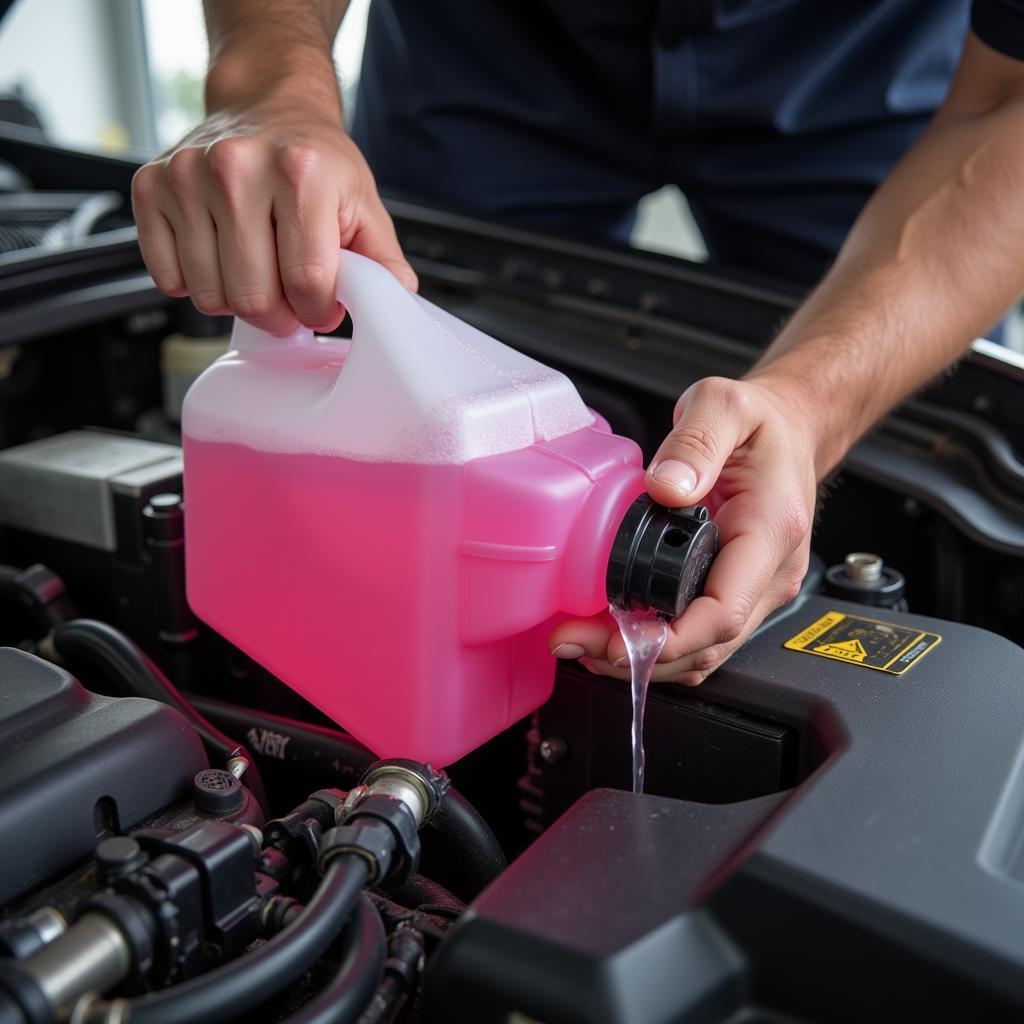Antifreeze, the unsung hero of your car’s cooling system, is more than just a colorful liquid. But have you ever wondered, “What color is antifreeze?” and what those colors mean for your vehicle? This comprehensive guide will delve into the fascinating world of antifreeze colors, their functions, and how to choose the right one for your car.
Deciphering the Antifreeze Rainbow: Why Colors Matter
Antifreeze, also known as engine coolant, is vital in regulating your engine’s temperature, preventing overheating, and protecting components from corrosion. While its primary function is consistent, the color variations signify different chemical compositions and are crucial for compatibility with your car model.
Unmasking the Common Antifreeze Colors
Let’s break down the common antifreeze colors and their characteristics:
- Green Antifreeze: Traditionally, green was the most prevalent antifreeze color, typically indicating an IAT (Inorganic Additive Technology) formula. While effective, IAT coolants require more frequent changes due to their shorter lifespan.
 Green Antifreeze
Green Antifreeze
-
Yellow Antifreeze: Often associated with extended life and universal compatibility, yellow antifreeze, like Prestone’s Cor-Guard, utilizes organic acid technology (OAT) for longer-lasting protection.
-
Orange Antifreeze: Similar to yellow, orange antifreeze commonly employs OAT technology and boasts an extended lifespan. However, it’s essential to verify compatibility as some orange variants might not be suitable for all car makes and models.
-
Pink Antifreeze: Typically found in newer vehicles, particularly those manufactured by General Motors, pink antifreeze signifies Dex-Cool, a type of OAT coolant designed for long-lasting performance.
 Pink Antifreeze in Car
Pink Antifreeze in Car
- Blue Antifreeze: Like green antifreeze, blue often signifies an IAT-based formula. However, it’s crucial to note that some HOAT (Hybrid Organic Acid Technology) coolants also come in blue.
Can I Mix Different Color Antifreeze? A Word of Caution
While the colorful spectrum of antifreeze might seem tempting to mix and match, doing so can have detrimental effects on your engine. Different antifreeze types utilize varying chemical compositions, and combining them can lead to:
-
Reduced Cooling Efficiency: Mixing incompatible antifreeze types can compromise the coolant’s ability to transfer heat effectively, potentially leading to overheating.
-
Corrosion and Deposits: Incompatible mixtures can create a corrosive environment within the cooling system, leading to rust, sediment buildup, and damage to engine components.
-
Voided Warranty: Using an incorrect antifreeze type can void your vehicle’s warranty, resulting in costly repairs down the line.
“Mixing antifreeze types is like mixing oil and water,” cautions automotive expert John Smith, lead mechanic at XYZ Auto. “It might seem harmless initially, but the long-term consequences can be severe for your engine.”
Choosing the Right Antifreeze: Consulting the Oracle (Your Owner’s Manual)
The best way to determine the correct antifreeze for your vehicle is to consult your owner’s manual. The manual will specify the recommended antifreeze type and color, ensuring compatibility and optimal performance.
Conclusion: Navigating the Antifreeze Color Code
Understanding the significance of antifreeze colors is crucial for maintaining your vehicle’s health and ensuring its longevity. By adhering to the manufacturer’s recommendations and resisting the urge to mix colors, you can keep your engine cool, protected, and running smoothly for miles to come.
FAQs
1. What happens if I add the wrong color antifreeze?
Adding the wrong color antifreeze can lead to reduced cooling efficiency, corrosion, and potential damage to your engine.
2. How often should I change my antifreeze?
Refer to your owner’s manual for specific recommendations. Generally, it’s advisable to change your antifreeze every 30,000 miles or every two to five years.
3. Can I use universal antifreeze in my car?
While some antifreeze types claim universal compatibility, it’s crucial to consult your owner’s manual to confirm suitability for your vehicle.
4. What is the difference between IAT, OAT, and HOAT antifreeze?
IAT, OAT, and HOAT refer to different antifreeze technologies, each with varying chemical compositions, lifespans, and compatibility requirements.
5. Where can I dispose of old antifreeze?
Antifreeze is toxic and should never be poured down the drain. Contact your local recycling center or hazardous waste disposal facility for proper disposal instructions.
For more information on specific antifreeze types, you can visit:
Remember, when it comes to your car’s cooling system, understanding the nuances of antifreeze colors can make all the difference in preventing costly repairs and keeping your engine running smoothly.
Need Expert Advice? Contact Color Box Hanoi today at 0373298888 or [email protected]. Visit us at 86 Cầu Giấy, Hà Nội, for personalized guidance on choosing the right paint and maintaining your car’s vibrant colors. Our team is available 24/7 to answer your questions and provide exceptional support.
